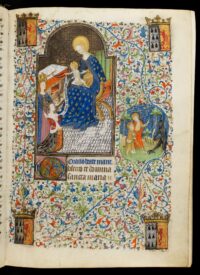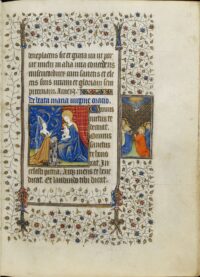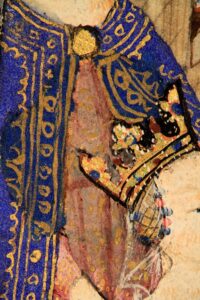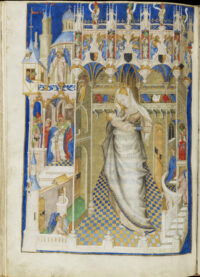 Infrared imaging has revealed that a 15th century Book of Hours was reworked to replace the first wife of a duke with a depiction of his second wife. Curators at the Fitzwilliam Museum noticed a strange darkened area on folio 20r of MS62, aka the Hours of Isabella Stuart. The dark area was examined in the laboratory using IR technology to reveal the underdrawing and the late first wife.
Infrared imaging has revealed that a 15th century Book of Hours was reworked to replace the first wife of a duke with a depiction of his second wife. Curators at the Fitzwilliam Museum noticed a strange darkened area on folio 20r of MS62, aka the Hours of Isabella Stuart. The dark area was examined in the laboratory using IR technology to reveal the underdrawing and the late first wife.
The Hours of Isabella Stuart was not made for Isabella Stuart. The manuscript was commissioned by Yolande of Aragon, Dowager Duchess of Anjou, who had it elaborately illuminated by artists in Angers known as the Rohan Masters. She gave the book to her daughter, Yolande of Anjou, around the time of her marriage to the future Duke Francis I of Brittany in 1431. Yolande died in 1440 and two years later Francis remarried to Isabella Stuart, daughter of James I of Scotland. Francis had his late wife’s prayer  book adapted as a wedding gift for his new wife by artists in Nantes. When Isabella’s daughter Margaret of Brittany got married (to her cousin, the future Duke Francis II) in 1455, the book passed to her. She had another Breton artist adapt the manuscript by adding a new illumination of Margaret kneeling before the Virgin and Child.
book adapted as a wedding gift for his new wife by artists in Nantes. When Isabella’s daughter Margaret of Brittany got married (to her cousin, the future Duke Francis II) in 1455, the book passed to her. She had another Breton artist adapt the manuscript by adding a new illumination of Margaret kneeling before the Virgin and Child.
With more than 500 figural scenes, this is one of the most extensively illuminated Book of Hours still in existence. The large miniatures depict scenes from the life of Mary and Jesus taken from each Gospel. Smaller marginal miniatures depict signs of the Zodiac and seasonal labor (in the Calendar), and of Christ and the saints inspired by the Book of Revelation and a 14th century cycle of allegorical poems illustrate the prayers. Dense floral designs infill the pages.
The central image on folio 20r depicts the Virgin and Child. Kneeling in front of her to the left is a woman wearing a ducal coronet. Behind her  stands St. Catherine. The dark blotch looms behind the coronet on the chest of St. Catherine. The overpainting was done in two stages. In the first stage, St. Catherine was added and the face and clothes of the original patron, Yolande of Anjou, were repainted to represent Isabella Stuart. The heraldic dress now featured the arms of Isabella Stuart, the Scottish lion rampant impaled (in the heraldic sense of a divided field) with the ermine of Brittany to denote her marriage. The same arms were added to the four corners of folio 20r and throughout the rest of the book.
stands St. Catherine. The dark blotch looms behind the coronet on the chest of St. Catherine. The overpainting was done in two stages. In the first stage, St. Catherine was added and the face and clothes of the original patron, Yolande of Anjou, were repainted to represent Isabella Stuart. The heraldic dress now featured the arms of Isabella Stuart, the Scottish lion rampant impaled (in the heraldic sense of a divided field) with the ermine of Brittany to denote her marriage. The same arms were added to the four corners of folio 20r and throughout the rest of the book.
In the second stage, Yolande’s head dress, which Isabella retained at first, was overpainted to blend into Catherine’s robe and the ducal coronet added. Yolande was never duchess because Francis didn’t succeed to the title until August 1442, two years after her death. When he commissioned the Nantes artist to make the changes to the Book of Hours, he and Isabella weren’t married yet, so the coronet was added after she became Duchess of Brittany.
 Analysis of the materials used laid out a timeline of the modifications. The Rohan Masters used malachite, ultramarine, lead white, red lead, brown earth and a pink derived from insects for their images. The two Nantes artist that made the modifications for Isabella and Margaret’s additions used less expensive materials — an organic green colorant instead of the mineral malachite, azurite instead of ultramarine and vermilion instead of red lead. The blue mantle of St. Catherine standing behind Isabella was painted with ultramarine initially, matching the rich blue of the Virgin’s garment, but when the kneeling patron’s headdress was covered up with the coronet, the front of St. Catherine’s robe was touched up with azurite. All of the blue elements in the Margaret of Brittany addition were made with azurite.
Analysis of the materials used laid out a timeline of the modifications. The Rohan Masters used malachite, ultramarine, lead white, red lead, brown earth and a pink derived from insects for their images. The two Nantes artist that made the modifications for Isabella and Margaret’s additions used less expensive materials — an organic green colorant instead of the mineral malachite, azurite instead of ultramarine and vermilion instead of red lead. The blue mantle of St. Catherine standing behind Isabella was painted with ultramarine initially, matching the rich blue of the Virgin’s garment, but when the kneeling patron’s headdress was covered up with the coronet, the front of St. Catherine’s robe was touched up with azurite. All of the blue elements in the Margaret of Brittany addition were made with azurite.
Richly illuminated manuscripts like this were expensive heirlooms and as they traded hands over the generations, the new owners liked to add their stamp to them. The addition of new heraldic elements, as was done here with Isabella Stuart’s arms, was more common.
Dr Reynolds said: “It’s a very exciting discovery.
“These books in a way are sort of archaeological sites and when you start to uncover what lies under these images it actually unlocks the human story of how these books were commissioned and then passed from one person to another as the story of these different marriages and different dynastic alliances evolved.”
She described the over-painting as “not unique but unusual”.
The Hours of Isabella Stuart has gone on display at the Fitzwilliam Museum’s new exhibition The Human Touch: Making Art, Leaving Traces. The manuscript has also been digitized and can be perused in high definition with copious fascinating annotations on the museum’s website.
In folio 20r, I wonder what object St. Catherine is holding? It looks like a bent board with two horns.
Part of a “Catherine wheel”, her attribute.
Catherine was to be martyred on the wheel but it was struck by lighting. The executioner pulled out his sword and beheaded her. Saints have whole tales of there martyrdom and attributes from those tales that help identify them.
relevant
https://www.poetryfoundation.org/poems/43768/my-last-duchess
in which “last” is being used to mean “previous”
In “Folio 20r”, Isabella Stuart’s “speech bubble” (the one that little Jesus is holding) reads: “o mother of god, remember me” / “mater dei memento mei”, and as it seems now, Mary DID(!) remember.
Of course, I am not quite sure if the text is in fact Yolande’s, or if it simply had been added to the scene together with Isabella Stuart 😆
The text continues with “[strange verb that I cannot decipher, “olaeto”?, “o lacto”?, “olacio”?], beate marie. ([that verb], ..blessed mary.) ..Maybe, something that Yolande would have said 😉
“..Obsecro te, domina sancta maria,..”. For the complete “obsecro te”, cf.: preces-latinae.org/thesaurus/BVM/ObsecroTe.html
:hattip: